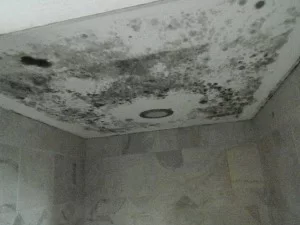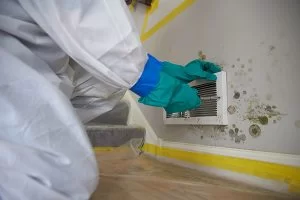Mold is a natural product of the environment—when it accumulates in the great outdoors, that is. When mold develops indoors, such as in your home, a significant issue arises.
Indoor mold growth can be dangerous if it is not addressed quickly because it can cause major property damage and affect your health. The longer mold is left in your home, the more likely serious damage and health issues can occur. It is important to be able to tell when there is a mold problem in your home and to take the right actions immediately to stop its spread and have it removed.
What exactly is mold?
 The black and grey splotches seen on walls in homes, near windows or in the damp recesses of a basement are likely to be mold spores. Mold is a fungi that rapidly spreads under the right conditions. Thousands or perhaps hundreds of thousands of mold species exist in the indoors and outdoors. Spores that have taken hold on property give off a distinct, musty odor, often recognizable as mold. A few common indoor molds include cladosporium, pencilium and aspergillus.
The black and grey splotches seen on walls in homes, near windows or in the damp recesses of a basement are likely to be mold spores. Mold is a fungi that rapidly spreads under the right conditions. Thousands or perhaps hundreds of thousands of mold species exist in the indoors and outdoors. Spores that have taken hold on property give off a distinct, musty odor, often recognizable as mold. A few common indoor molds include cladosporium, pencilium and aspergillus.
Indoors, mold grows in warm, humid conditions. The fungi feeds on moisture, such as in water-logged basements, behind bathroom wallpaper, or under damp carpeting. Mold also uses organic materials like cellulose, which is found in common building materials like drywall and wood, as a food source. Structural elements affected by mold like wood, walls, and ceilings may experience serious structural damage as the mold eats away at these materials.
The spores can be found floating throughout the air. If they land on a dampened spot, the spores flourish, leading to a messy mold problem. Mold colonies can also disperse their spores which cause mold growth to appear in new places.
Why is mold dangerous?
Mold growth within a home appears to be just a mild nuisance to uninformed homeowners. In fact, mold spores are strong enough to weaken the structures upon which they inhabit. Drywall and flooring are typical places mold can grow, leaving those structures vulnerable to rapid deterioration.
The fungi is even hazardous to the health of humans. Those who are sensitive to mold spores experience coughing, sneezing, watery eyes, a runny nose, and itchy skin when they inhale or touch mold spores. People who are allergic to mold suffer more severe reactions, like breathing difficulties and fever. Those whose immune systems are weakened tend to suffer from mold infections. Mold can even spur the development of asthma in some individuals.
The danger of mold is enough to warrant frequent inspections of your home to ensure that mold spores are stopped in their tracks immediately upon detection.
Types of Mold
As mentioned above, there are many different types of mold species that can form indoors. Different types of mold may appear as different colors including black, green, orange, and white. Stachybotrys chartarum, also known as black mold, is a common type of indoor mold that is dangerous for your health. Cladosporium is another type of mold that may appear black or green and is likely to form in moist areas and on painted surfaces. All types of mold are likely to trigger health issues and cause damage which is why you need to be able to effectively detect and remove mold growth.
Mold vs Mildew
Mildew and mold can both affect your home and while many people refer to mold and mildew interchangeably, they are not the same thing. Mold is a general term that refers to many species of mold while mildew is a type of mold. Mildew is white and powdery in appearance and generally appears on damp surfaces such as tile, grout, and walls. In most cases, mildew can be scrubbed away using a brush and store-bought mold killer.
How to detect mold
Mold can be discovered with a visual inspection. Regularly examine your home for signs of mold: musty odors, especially in areas that have recently flooded or experienced a water leak, and black or green splotches. Get a flashlight and peer into your heating vents, under the sinks, along walls and ceilings, under and around appliances, in the attic (where mold often thrives), and even under and along porous surfaces, like carpeting. If you notice any discoloration that cannot be readily explained, it is likely mold.
Sometimes, mold is not visible to the naked eye, such as mold growing behind wallpaper or in darkened areas of a basement. Plus, some mold spores may be too tiny to detect right away. Test the area to determine for certain that the area is indeed moldy. Experts recommend purchasing a surface test that will detect mold in areas of your home. Typical mold tests may use swabs or special tape to pick up evidence of mold growth.
In addition to the surface test, an air sampling kit can be purchased to detect mold spores floating in the air. Experts suggest using a combination of both the surface test and air sampling test for good measure. Air sampling tests can detect both living and dead mold spores. If you fail to visually find any mold growth in your home, mold may still be present as mold spores in the air. The air sampling kit will give you accurate results.
Homeowners also utilize moisture meters to detect the levels of moisture along walls and ceilings. Any detection of water damage should be followed with a close visual inspection for the presence of mold. The fungi only thrives in moisture-ridden areas. Where there is no moisture, mold ceases to exist.
Once you detect mold in your home, you can take the necessary steps to eliminate all traces of the mold growth and remove any likelihood of its return.
How to eliminate mold
Mold feeds on moisture. If your home has any leaks, frequent flooding or condensation, mold spores will find those spaces to be a nourishing well. Eliminate the moisture, and the mold will have nowhere to thrive. The first step in tackling mold growth is to fix any leaks or reoccurring condensation in your home. After the mold is removed, it will be less likely to return without a dependable source of moisture to feed upon.
Next, seal off any doorways that lead to other parts of the home to prevent mold spores from contaminating other areas. Heavy plastic works well as a sealer. You can also set up exhaust fans near windows and doors to the outside to help push mold spores out of the home. Wear protective gear, including gloves, goggles, and an N-95 mask, to avoid contact with any fungal spores. Mold removal products from a local hardware store can be used to disinfect the mold-covered spaces.
You may be able to remove mold growth from non-porous surfaces such as cabinets, vanities, and countertops by wiping it away with water and dish soap using a scrub brush, cloth, or sponge. For porous surfaces such as drywall, you should spray the surface with a 50/50 white vinegar solution and 3% hydrogen peroxide and scrub the mold. If the mold growth on a porous surface is severe, calling mold remediation professionals may be best.
All cleaning supplies, like sponges, gloves, and sprays, should be tossed into a garbage bag and safely removed farthest away from the main areas of the home to avoid spreading the mold spores.
Prevent mold
Homeowners can take steps to prevent mold contamination by controlling the moisture and humidity level in their home. Some simple steps include using a dehumidifier regularly, opening windows, and running fans often to rid excess moisture from the indoors. Any water pipe leaks should be addressed promptly. Ensure that upholstery, clothing, and other materials remain dry. All items stored within a home should be kept in well-ventilated areas. Consider tossing any belongings that have been affected by mold.
You should also target areas most vulnerable to mold including attics, basements, crawlspaces, kitchens, and bathrooms. Using a dehumidifier in these areas will decrease the moisture level in the air which makes mold growth less likely to occur. In kitchens and bathrooms, use fans and open windows for ventilation and always wipe down wet surfaces.
Professional Mold Removal

If mold has taken hold within a large area of your home, it is best to contact a professional mold remediation company such as ServiceMaster Restoration and Cleaning to remove and restore your home to its pre-damaged condition. Our skilled technicians will first assess the level of mold within your home, including a moisture assessment, then remove moldy contents, perform an air quality control and cleaning procedure, and finally complete a sanitization and anti-microbial application to eliminate all traces of mold. ServiceMaster Restoration and Cleaning is a licensed mold remediation company available 24 hours a day to take your call.

